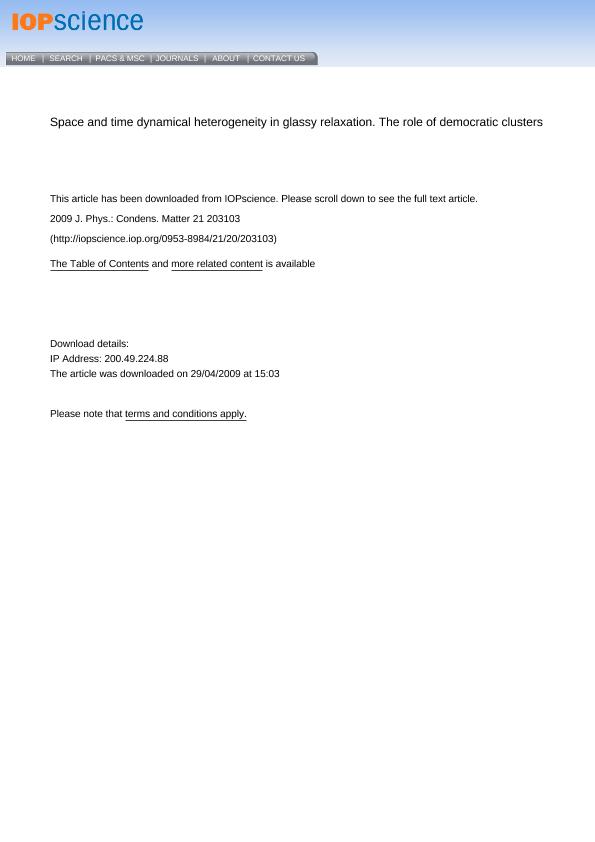Mostrar el registro sencillo del ítem
dc.contributor.author
Appignanesi, Gustavo Adrian

dc.contributor.author
Rodriguez Fris, Jorge Ariel

dc.date.available
2018-12-10T14:39:33Z
dc.date.issued
2009-05
dc.identifier.citation
Appignanesi, Gustavo Adrian; Rodriguez Fris, Jorge Ariel; Space and time dynamical heterogeneity in glassy relaxation. The role of democratic clusters; IOP Publishing; Journal of Physics: Condensed Matter; 21; 20; 5-2009; 1-14
dc.identifier.issn
0953-8984
dc.identifier.uri
http://hdl.handle.net/11336/66171
dc.description.abstract
In this work we review recent computational advances in the understanding of the relaxation<br />dynamics of supercooled glass-forming liquids. In such a supercooled regime these systems<br />experience a striking dynamical slowing down which can be rationalized in terms of the picture<br />of dynamical heterogeneities, wherein the dynamics can vary by orders of magnitude from one<br />region of the sample to another and where the sizes and timescales of such slowly relaxing<br />regions are expected to increase considerably as the temperature is decreased. We shall focus on<br />the relaxation events at a microscopic level and describe the finding of the collective motions of<br />particles responsible for the dynamical heterogeneities. In so doing, we shall demonstrate that<br />the dynamics in different regions of the system is not only heterogeneous in space but also in<br />time. In particular, we shall be interested in the events relevant to the long-time structural<br />relaxation or α relaxation. In this regard, we shall focus on the discovery of cooperatively<br />relaxing units involving the collective motion of relatively compact clusters of particles, called<br />?democratic clusters? or d-clusters. These events have been shown to trigger transitions between<br />metabasins of the potential energy landscape (collections of similar configurations or structures)<br />and to consist of the main steps in the α relaxation. Such events emerge in systems quite<br />different in nature such as simple model glass formers and supercooled amorphous water.<br />Additionally, another relevant issue in this context consists in the determination of a link<br />between structure and dynamics. In this context, we describe the relationship between the<br />d-cluster events and the constraints that the local structure poses on the relaxation dynamics,<br />thus revealing their role in reformulating structural constraints.
dc.format
application/pdf
dc.language.iso
eng
dc.publisher
IOP Publishing

dc.rights
info:eu-repo/semantics/openAccess
dc.rights.uri
https://creativecommons.org/licenses/by-nc-sa/2.5/ar/
dc.subject
Glasses
dc.subject
Dynamicsl Heterogeneities
dc.subject
Relaxation
dc.subject
Glass Transition
dc.subject.classification
Otras Ciencias Químicas

dc.subject.classification
Ciencias Químicas

dc.subject.classification
CIENCIAS NATURALES Y EXACTAS

dc.title
Space and time dynamical heterogeneity in glassy relaxation. The role of democratic clusters
dc.type
info:eu-repo/semantics/article
dc.type
info:ar-repo/semantics/artículo
dc.type
info:eu-repo/semantics/publishedVersion
dc.date.updated
2018-11-22T14:30:58Z
dc.journal.volume
21
dc.journal.number
20
dc.journal.pagination
1-14
dc.journal.pais
Reino Unido

dc.journal.ciudad
Londres
dc.description.fil
Fil: Appignanesi, Gustavo Adrian. Consejo Nacional de Investigaciones Científicas y Técnicas. Centro Científico Tecnológico Conicet - Bahía Blanca. Instituto de Química del Sur. Universidad Nacional del Sur. Departamento de Química. Instituto de Química del Sur; Argentina
dc.description.fil
Fil: Rodriguez Fris, Jorge Ariel. Consejo Nacional de Investigaciones Científicas y Técnicas. Centro Científico Tecnológico Conicet - Bahía Blanca. Instituto de Química del Sur. Universidad Nacional del Sur. Departamento de Química. Instituto de Química del Sur; Argentina
dc.journal.title
Journal of Physics: Condensed Matter

dc.relation.alternativeid
info:eu-repo/semantics/altIdentifier/doi/https://dx.doi.org/10.1088/0953-8984/21/20/203103
dc.relation.alternativeid
info:eu-repo/semantics/altIdentifier/url/http://iopscience.iop.org/article/10.1088/0953-8984/21/20/203103
Archivos asociados
